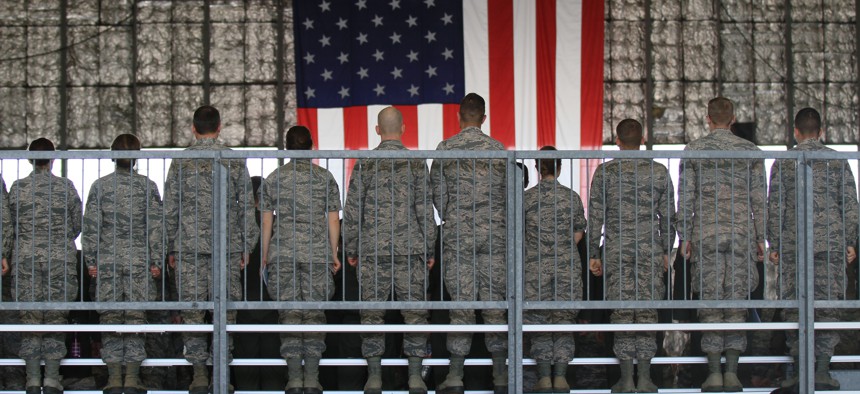
Spc. Ashley Low/U.S. Army National Guard
US Military: Sexual Assault in the Ranks Is Less Prevalent, and Better Reported
But defense officials say that with an estimated 14,900 cases last year, there’s still work to be done.
Look at the number of reported sexual assaults in the U.S. military over the last decade, and you’d likely be alarmed at the trend line. In 2016, as in many of the previous 10 years, the total number of reports increased—most recently to 6,172, up from 6,083 the year before. But that’s because more service members are reporting unwanted sexual contact, not experiencing it, according to the Pentagon’s latest Annual Report on Sexual Assault in the Military.
“Overall, this year's report shows indications of progress,” Elizabeth Van Winkle, acting assistant secretary of defense for readiness, said Monday. “With that said, the fight to end sexual assault, sexual harassment, and related misconduct in the military is far from over.”
In addition to analyzing those 6,172 reports, the Sexual Assault Prevention and Response Office, or SAPRO, surveyed more than 150,000 active-duty service members. This year’s key finding: Fewer service members are being assaulted — defined as anything from being groped to raped — and more of those who do are reporting it. About 32 percent of the estimated 14,900 victims filed a report in 2016, the annual report estimates.
“It shows that clearly, the department is doing a better job of giving confidence to service members about the fact that we actually will deal with the report and the allegations,” a senior defense official told several reporters Friday. “There’s still work to be done, but it’s a positive trend.”
Still, that means an estimated 4.3 percent of female service members were assaulted in 2016, down from 4.9 percent in 2014. For male service members, the prevalence decreased from 0.9 percent to 0.6 percent.
These decreases suggest that for the first time since the Pentagon started looking at this in 2004, women likely make up the majority of victims. (Because the military is comprised predominantly of men, there have historically been more total male victims, even if any given man is less likely to experience it.)
That change won’t alter SAPRO’s approach—male victims experience unique challenges of their own, the survey found, including significantly lower reporting rates and lower satisfaction with the reporting process when they do so—but it does show the continued challenges faced by women in uniform.
“We’ll keep on doing what we’re doing to support them,” another defense official told reporters. “We want to make sure that anybody that walks through the door gets the care and services they need … We don’t get to pick and choose who we support. We gotta do it perfect for everybody — that’s a big order, and we still have a long way to go.”
That’s shown by this spring’s Marines United scandal, in which a journalist and retired Marine exposed a secret Facebook group used to share explicit photos and videos of hundreds of female Marines and veterans without their consent. It drew condemnation from the Marine Corps Commandant, Gen. Robert Neller, but ultimately the sharers may be difficult to prosecute.
Related: The Marine Photo Scandal and the Cost of Indifference
“It highlights, and the survey data supports, that sexual harassment is in the area that we need to make further progress,” SAPRO Deputy Director Dr. Nate Galbreath said Monday at the annual report’s release.
Other persistent issues include the continued fear of retaliation. “Over half of service members reporting a sexual assault received some kind of negative reaction from other service members after making a report,” SAPRO Director Rear Adm. Ann Burkhardt said Monday. A third of those qualified as retaliatory behavior, according to the report.
Addressing that will require a commitment from all levels of leadership, from the secretary’s office to enlisted leaders, multiple defense officials said.
“I think this strategy is two-fold: one, sustained leadership engagement, [two], understanding that leaders at all levels need to take responsibility to affecting the microclimates they need,” Burkhardt said. “And that's where — in those small levels — you're going to make a lot of difference.”
The office has also started working with the Centers for Disease Control to find other ways to prevent assaults and support victims after they occur.




